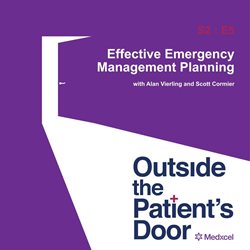(5/23/2022)
When dealing with an emergency situation, the greatest strength in an organization is a well-developed plan. And, if there’s any period of time that taught us the importance of emergency management plans, it’s been the COVID-19 pandemic. Every community relies on healthcare to serve its people. In times of crisis, this is even more apparent as patient care becomes critical to the health of the community.

However, emergency management plans go much deeper than patient care. To start, here are five key components to an effective emergency management plan:
Start with a clear mission or goal.
You can then use that goal to drive the decisions about safety, services, capabilities and capacity, among other components. For example, during a natural disaster like a hurricane, your primary goal may be that “everybody goes home”, and during the COVID-19 pandemic it may be that “nobody dies”. These goals reinforce how you think about safety, staffing, services and more.
Make each plan simple and usable.
Complex plans fail in a crisis. There’s a consistent theme in healthcare that works, and that is to keep it simple. Emergency plans that are straightforward and divided up into manageable blocks are critical. Plans that require overthinking or too many steps become difficult to execute. If there's anything about a plan in general that has to work really well, it is the ability for that plan to be read, understood and communicated quickly and then, of course, executed. If the plan is too complicated, teams cannot perform it as intended during a disaster.
Focus on proactive relationship-building and partnerships.
It's all about relationships that you form today in anticipation of what may or may not happen tomorrow. As part of emergency management and preparation, organizations must focus on building and maintaining critical relationships within their communities. From law enforcement and EMS to hospital peers, utility companies and community leaders beyond politicians, these relationships can make or break the execution and success of an emergency management plan when a crisis hits. By nurturing these relationships on an ongoing basis, you know who to contact and how to contact them at a moment’s notice. In addition, these contacts know who you are and are prepared to respond.
Integrate emergency management and business continuity.
We often combine emergency management and business continuity plans together, but in order to be most effective, they need to live separately while remaining integrated. Emergency management plans cover the healthcare location, while the business continuity plans focus on the department levels. It’s second nature for hospitals and healthcare facilities to focus on patient care in a time of crisis, but what is often overlooked are basic operations integral to keeping the business functioning. Business continuity supports patient care, and vice versa.
Review plans annually with all stakeholders.
“Review, evaluate and adjust” are commonplace when it comes to strategic plans. This is true for emergency plans, too. The key here is to review them with all stakeholders in the plan – including leadership, volunteers, contractors, patient care teams and so on.
To learn more about creating effective emergency management plans, listen to Season 2, Episode 5 of our podcast,
Outside the Patient’s Door: “
Effective Emergency Management Planning with Alan Vierling and Scott Cormier.”